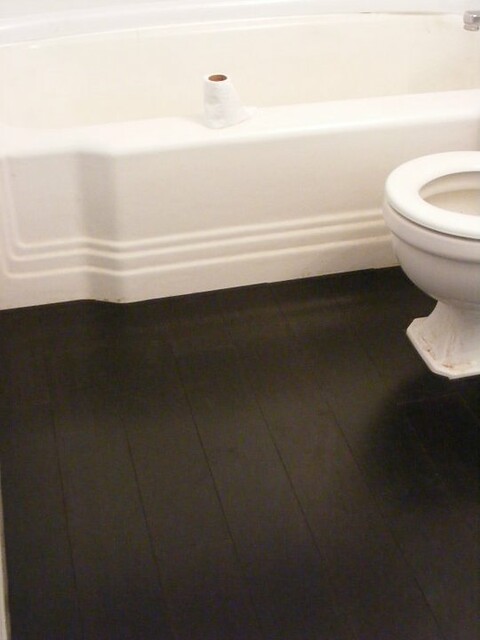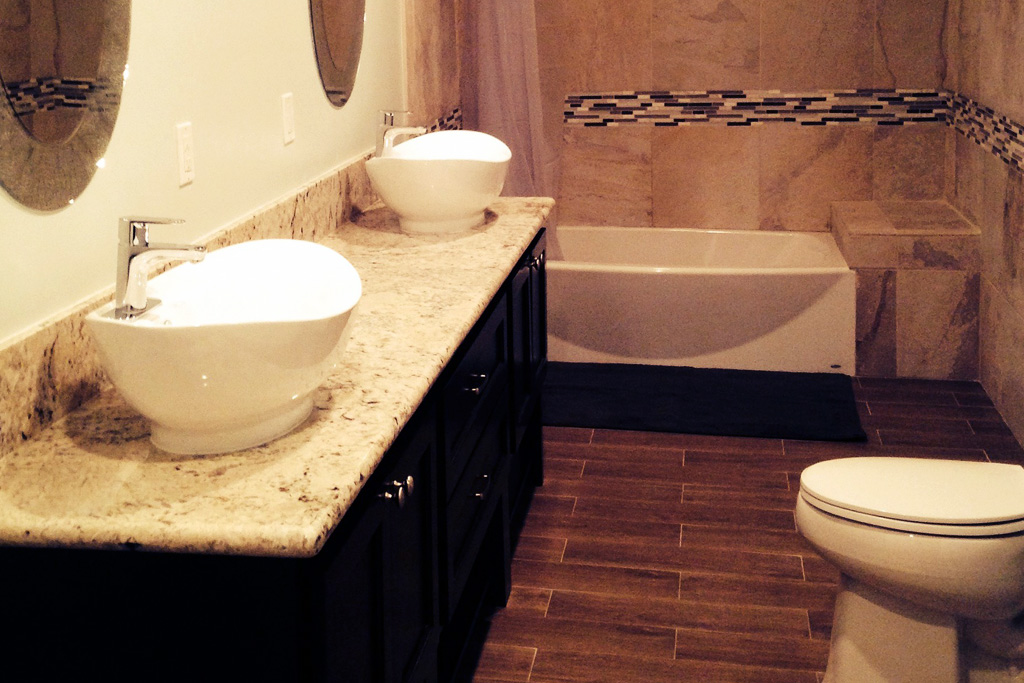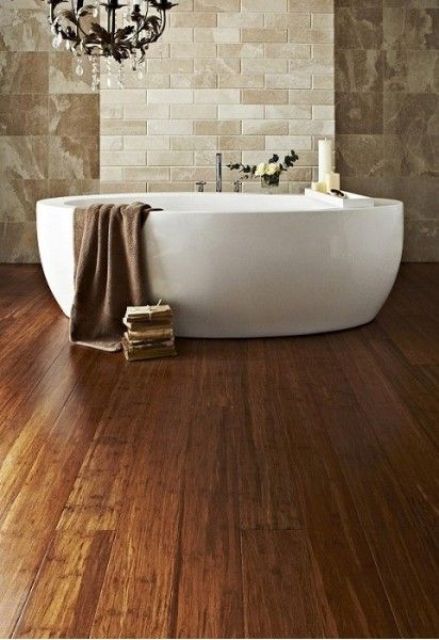Bamboo Flooring: Benefits and Drawbacks
Bamboo flooring is a popular choice for homeowners seeking an eco-friendly and stylish option for their floors. However, like any material, it has its pros and cons. Let’s talk about the benefits and drawbacks of bamboo flooring to help you make an informed decision.
- Eco-Friendly Nature: One of the most significant benefits of bamboo flooring is its sustainability. Bamboo is a rapidly renewable resource, with the ability to reach maturity in just five to seven years compared to the decades required for hardwood trees. This makes bamboo an environmentally friendly choice for flooring.
- Durability and Strength: Bamboo flooring is known for its durability. Strand-woven bamboo, in particular, is incredibly hard and can withstand heavy foot traffic, making it suitable for high-traffic areas in the home. It’s also resistant to scratches and dents, which is a significant advantage over other types of flooring.
- Aesthetic Appeal: Bamboo flooring offers a unique and natural aesthetic that can complement various interior styles. Its distinctive grain patterns and natural color variations provide a warm and inviting look. Additionally, it can be stained in various shades, offering versatility in design.
- Easy Maintenance: Maintaining bamboo flooring is relatively simple. Regular sweeping or vacuuming to remove dirt and debris, along with occasional mopping with a damp cloth, is usually sufficient to keep it looking pristine. This low-maintenance aspect is appealing to busy homeowners.
- Cost Considerations: While bamboo flooring is often more affordable than traditional hardwood, the price can vary depending on the type and quality of the bamboo. Engineered bamboo flooring can be more expensive but offers enhanced durability and moisture resistance.
- Potential Drawbacks: Despite its many benefits, bamboo flooring has some drawbacks. It can be susceptible to moisture and humidity, which can cause warping or swelling if not properly sealed and maintained. Additionally, low-quality bamboo flooring can be prone to scratches and dents, and the manufacturing process can sometimes involve the use of formaldehyde-based adhesives, which are a health concern.

Bamboo Flooring and Moisture
When considering bamboo flooring for a bathroom, understanding its relationship with moisture is crucial. Bathrooms are naturally humid environments, and we will explore how bamboo flooring interacts with moisture and how to mitigate potential issues.
Moisture Sensitivity
Bamboo flooring, like other natural materials, is sensitive to moisture. Excessive exposure to water can cause it to expand, warp, or even develop mold. This sensitivity makes it essential to manage moisture levels effectively in areas where bamboo flooring is installed.
Proper Sealing
One of the most effective ways to protect bamboo flooring from moisture is through proper sealing. Applying a high-quality sealant can create a protective barrier that prevents water from penetrating the bamboo. This step is especially important in bathrooms, where water exposure is inevitable.
Humidity Control
Maintaining consistent humidity levels is crucial for preserving bamboo flooring. Using a dehumidifier can help regulate humidity in the bathroom, reducing the risk of moisture-related damage. It’s also advisable to ensure proper ventilation in the bathroom to allow moisture to dissipate quickly.
Quick Spill Cleanup
Spills should be cleaned up immediately to prevent water from seeping into the bamboo flooring. This proactive approach can minimize the risk of damage. Placing rugs or mats in areas prone to water exposure, such as near the sink or bathtub, can also help protect the flooring.
Choosing the Right Bamboo Type
Not all bamboo flooring is created equal when it comes to moisture resistance. Strand-woven bamboo, which is denser and more durable, tends to be more resistant to moisture than horizontal or vertical bamboo. Choosing the right type of bamboo can make a significant difference in performance.
Professional Installation
Hiring a professional to install bamboo flooring in a bathroom can ensure that it is done correctly. Professionals can take additional steps to enhance moisture resistance, such as using moisture barriers and ensuring proper sealing around the edges and seams.
Types of Bamboo Flooring Suitable for Bathrooms
Selecting the right type of bamboo flooring is critical, especially for moisture-prone areas like bathrooms. Different types of bamboo flooring offer varying levels of durability and moisture resistance. Here are the types best suited for bathroom installations.
Strand-Woven Bamboo
Strand-woven bamboo is one of the best options for bathrooms due to its high density and durability. Made by compressing bamboo fibers under extreme heat and pressure, it is harder and more moisture-resistant than traditional bamboo flooring. This makes it ideal for environments where moisture is a concern.
Engineered Bamboo
Engineered bamboo flooring consists of a bamboo veneer atop a plywood or fiberboard base. This construction enhances its stability and moisture resistance compared to solid bamboo. Engineered bamboo is less likely to expand or contract with changes in humidity, making it a good choice for bathrooms.
Horizontal and Vertical Bamboo
Horizontal and vertical bamboo flooring are constructed differently but offer similar benefits. Horizontal bamboo has a wider grain pattern, while vertical bamboo has a more uniform appearance. While these types are aesthetically pleasing, they are less dense and more prone to moisture damage compared to strand-woven or engineered bamboo.
Floating Floor Installation
A floating floor installation can be advantageous in bathrooms. This method involves laying bamboo planks over a foam or cork underlayment without gluing or nailing them to the subfloor. The underlayment provides a moisture barrier and allows the flooring to expand and contract with changes in humidity.
Click-Lock Bamboo Flooring
Click-lock bamboo flooring is a type of floating floor that is easy to install and offers good moisture resistance. The planks snap together without the need for adhesives, reducing the risk of water damage. This type of installation is also more forgiving in high-moisture environments.
Waterproof Bamboo Options
Some manufacturers offer waterproof or water-resistant bamboo flooring specifically designed for wet areas. These products are treated with special sealants and finishes that provide an extra layer of protection against moisture. While typically more expensive, they offer peace of mind in high-moisture areas like bathrooms.
Installation Tips for Bamboo Flooring in Bathrooms
Proper installation is crucial for ensuring the longevity and performance of bamboo flooring in a bathroom. Below we provide detailed tips and best practices for installing bamboo flooring in such a moisture-prone environment.
Acclimate the Flooring
Before installation, it’s essential to acclimate the bamboo flooring to the bathroom’s environment. Store the planks in the bathroom for at least 72 hours to allow them to adjust to the room’s temperature and humidity. This step helps prevent warping or buckling post-installation.
Prepare the Subfloor
The subfloor must be clean, dry, and level before installation. Any imperfections in the subfloor can affect the performance and appearance of the bamboo flooring. If the subfloor is concrete, consider applying a moisture barrier to prevent moisture from seeping up into the bamboo.
Use a Moisture Barrier
Installing a moisture barrier between the subfloor and the bamboo planks is critical in a bathroom. This barrier can be a plastic sheet, foam underlayment, or a specialized moisture-resistant underlayment. It helps protect the bamboo from moisture that might seep through the subfloor.
Seal the Edges
Sealing the edges of the bamboo flooring where it meets walls and fixtures can prevent water from penetrating the seams. Use a high-quality waterproof sealant or silicone caulk to fill gaps and ensure a watertight seal. This step is particularly important around bathtubs, showers, and sinks.
Consider Floating Installation
A floating floor installation is often recommended for bathrooms. This method allows the floor to expand and contract without causing damage. It also provides an additional moisture barrier with the use of an underlayment, enhancing the floor’s resistance to water.
Hire a Professional
While DIY installation is possible, hiring a professional can ensure that the bamboo flooring is installed correctly and to industry standards. Professionals have the experience and tools necessary to address potential challenges, such as uneven subfloors and moisture concerns, ensuring a successful installation.
Maintenance and Care for Bamboo Bathroom Flooring
Maintaining bamboo flooring in a bathroom requires special attention due to the high-moisture environment. Proper care can extend the life of your bamboo flooring and keep it looking beautiful. Let’s outline essential maintenance and care tips.
Regular Cleaning
Regular cleaning is essential to maintain the appearance and longevity of bamboo flooring. Sweep or vacuum the floor regularly to remove dirt and debris that can cause scratches. Use a damp mop with a mild cleaning solution designed for bamboo flooring for deeper cleaning.
Immediate Spill Cleanup
Promptly cleaning up spills is crucial in a bathroom setting. Water left standing on bamboo flooring can cause damage, so always wipe up spills immediately with a dry cloth. Placing absorbent mats near sinks, bathtubs, and showers can help catch water and prevent it from reaching the floor.
Avoid Harsh Cleaners
Harsh chemicals and abrasive cleaners can damage the finish of bamboo flooring. Use pH-neutral cleaning products specifically formulated for bamboo or hardwood floors. Avoid using vinegar, ammonia, or wax-based products, as they can dull the finish and cause long-term damage.
Maintain Humidity Levels
Controlling humidity levels in the bathroom is vital for bamboo flooring. Use a dehumidifier to reduce moisture in the air, and ensure proper ventilation by using exhaust fans during and after showers. Maintaining humidity levels between 40-60% can prevent the bamboo from warping or swelling.
Protect the Surface
Protecting the surface of your bamboo flooring can help maintain its appearance. Place rugs or mats in high-traffic areas and near water sources to reduce wear and tear. Use felt pads on the bottom of furniture to prevent scratches, and avoid dragging heavy objects across the floor.
Regular Inspections and Maintenance
Regularly inspect the flooring for signs of damage, such as scratches, dents, or warping. Address any issues promptly to prevent them from worsening. Periodically reapply a protective sealant to maintain the moisture resistance of the bamboo flooring, ensuring it remains protected over time.
Comparing Bamboo to Other Bathroom Flooring Options
When choosing flooring for a bathroom, it’s essential to consider all available options. Bamboo is just one of many materials that can be used. Let’s compare bamboo flooring to other popular bathroom flooring options to help you make an informed decision.
Bamboo vs. Tile
Tile is a common choice for bathroom flooring due to its water resistance and durability. While bamboo offers a warm and natural look, tile provides superior moisture resistance and is less likely to be damaged by water. However, tile can be cold and hard underfoot, whereas bamboo provides a more comfortable surface.
Bamboo vs. Vinyl
Vinyl flooring is another popular option for bathrooms due to its water resistance and affordability. High-quality vinyl can mimic the appearance of natural materials like wood or stone. While bamboo offers an eco-friendly option, vinyl is highly durable and easier to maintain in a bathroom environment.
Bamboo vs. Laminate
Laminate flooring can offer the appearance of wood at a lower cost, but it is not as moisture-resistant as bamboo. Water can seep into the seams of laminate, causing it to swell and warp. Bamboo, especially strand-woven or engineered bamboo, can provide better moisture resistance if properly sealed and maintained.
Bamboo vs. Natural Stone
Natural stone flooring, such as marble or slate, is highly durable and water-resistant, making it an excellent choice for bathrooms. However, stone can be expensive and requires regular sealing to maintain its appearance. Bamboo is a more affordable and sustainable option, though it requires careful maintenance to protect against moisture.
Bamboo vs. Cork
Cork flooring is another eco-friendly option that offers a comfortable and warm surface underfoot. It has natural water-resistant properties, but it still requires sealing to prevent water damage. Bamboo can be more durable than cork, especially in high-traffic areas, but cork provides better thermal and acoustic insulation.
Bamboo vs. Hardwood
Hardwood flooring is rarely recommended for bathrooms due to its sensitivity to moisture. Bamboo can be a better alternative, offering a similar aesthetic with improved moisture resistance, especially when using strand-woven or engineered varieties. Both options require careful maintenance to prevent water damage.
Can I install bamboo flooring in a bathroom?
Can I install bamboo flooring in a bathroom? Ambient Bamboo Flooring
Bamboo Flooring Ideas With Pros And Cons
Can I use Bamboo Flooring in my Bathroom?
iDesign Formbu Bamboo Floor Mat Non-Skid, Water-Repellent Runner Rug for Bathroom, Kitchen, Entryway, Hallway, Office, Mudroom, Vanity, 24″ x 48
Cork Floors for Bathrooms Bamboo bathroom, Best bathroom
Related Posts:










